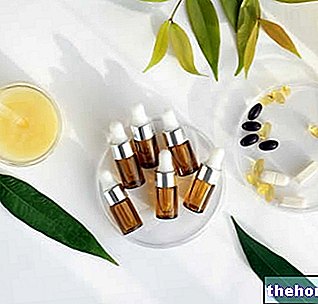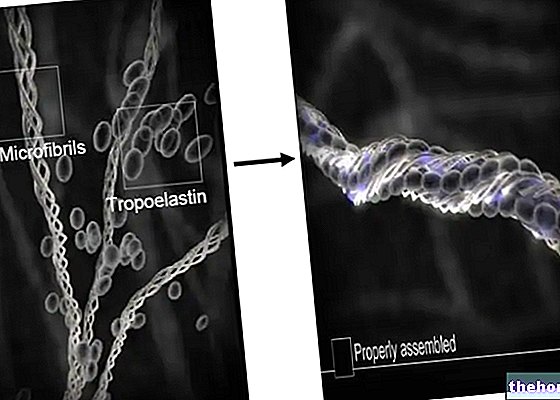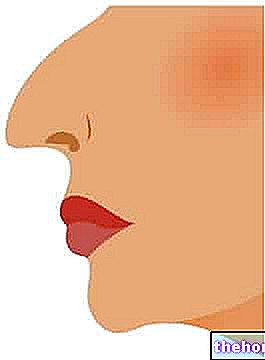So is Acne
Acne is an inflammatory pathology of the skin tissue, characterized by inflammation of the hair follicle and the sebaceous gland. It all begins with the desquamation of the keratinocytes and with the consequent obstruction of the follicle; in this way the sebum secreted by the sebaceous gland is unable to escape and accumulates on site, favoring microbial contamination by Propionibacterium acnes.

Signs and Symptoms
The symptomatological manifestations of acne are evident and generally very accentuated on the face: they are comedones, papules, cysts, up to real scars that also affect the dermis.
Types of Acne
Basically, it is possible to distinguish two different forms of acne: endogenous acne and exogenous acne.
Endogenous acne - otherwise defined as vulgar or juvenile acne - affects the skin area of the face, chest, shoulders and trunk; it can arise due to hereditary or environmental factors, such as eating disorders and stress.
The appearance of this form of acne is very common in puberty and is therefore called juvenile acne. This time span is, in fact, characterized by an "overproduction of androgens, which lead to a" sebaceous hypersecretion with the formation of comedones. The blackhead can be followed by an inflammatory process triggered by the action of P.ropionibacterium acnes: this bacterium hydrolyzes the sebum to free fatty acids, which have a "chemo tactical action on the tissues of the dermis.
Exogenous acne, on the other hand, is a type of acne characterized by clinical dermatosis of an iatrogenic, cosmetic nature, or even triggered by pollutants in the workplace.
Acne Medicines
For more information, read: Acne: Causes and Drugs
The drugs that can be used for the treatment of acne are different. The choice to use an active ingredient rather than another is up to the doctor only and depends on a series of factors, such as the triggering cause, the type of acne that afflicts the patient, the severity with which it occurs and the patient's response to the same treatment.
Antibiotics
One of the possible therapeutic strategies for the treatment of acne involves the administration of topical antibiotics, such as clindamycin and erythromycin.
These antibiotics inhibit the 50S ribosomal sub-unit of the bacterium, thus stopping the process of formation of the polypeptide chain; ultimately this block of protein synthesis causes the arrest of bacterial proliferation. They are antibiotics with bacteriostatic action, but at high doses they can become bactericidal. The most common side effects are also carried out on the skin, with burning, dryness and irritation in the area of application.

In particularly severe cases of acne, the doctor may decide to proceed with the oral administration of antibiotic drugs.
Did you know that.
Contrary to popular belief, the treatment of acne with antibiotic drugs is NOT the first choice drug therapy, as, in many cases, bacterial infection is a consequence of acne and not the primary cause.
In these circumstances, in fact, taking antibiotics could not only lead to unsatisfactory results, but even give rise to resistance phenomena.
It is therefore clear why doctors try to limit the use of antibiotics as much as possible.
Topical antimicrobials
Benzoyl peroxide and azelaic acid are both used as topical antimicrobials.
In addition to the antibacterial action, both of the aforementioned active ingredients are also endowed with keratolytic and comedolytic properties, very useful in the treatment of acne and its typical manifestations.
Retinoids
Retinoids are powerful dermatological drugs, widely used. In particular, the "acidoretinoic or tretinoin, applied to the skin - where it has an absorption of less than 10% - favors the desquamation of keratinocytes and cell turnover; for this reason with the first treatments we complain of a worsening of the disease, while the" therapeutic effect manifests itself over time. It can also be applied to photo-damaged skin because it promotes the synthesis of collagen and new blood vessels. Retinoic acid should be applied to dry skin, avoiding delicate areas such as the nostrils, eyes, lips and mucous membranes. It is a molecule insoluble in water and highly photo-sensitive so it is advisable not to expose yourself to sunlight during the treatment.
Another active ingredient of this pharmacological category is isotretinoin, a synthetic retinoid used for the therapy of cystic acne. The treatment takes place by oral administration and is very effective; in this case too, however, attention must be paid to possible side effects: in addition to dryness and irritation of the skin, a teratogenic effect has been demonstrated, which however persists for a long time even after the interruption, since the drug is eliminated very slowly.
Corticosteroids
Other dermatological drugs used in the pharmacological treatment of acne are corticosteroids for topical use, used for their anti-inflammatory activity. The formulation in lotions, gels, ointments and creams is suitably developed with vehicles that facilitate the absorption of the active principle. The application of moderate-acting glucocorticoids is frequent in cases of acne, seborrheic dermatitis, allergic dermatitis and keratosis; for more serious pathologies such as cystic acne local injections are required.

Keratolytics
Even keratolytic agents can be used in the treatment of acne. These substances are able to thin the thickening of the skin tissue, better known as keratosis. Keratoses are skin diseases, which mainly involve the palmar skin areas: in this case we speak of palmar keratoderma, or they can occur in areas traumatized by "excessive sun exposure and in this case we will have actinic keratosis, characterized by grayish patches with a reddish halo; or there may be pilar keratoses characterized by a thickening of the orifices of the hair bulbs at the level of the extensor areas of the thighs and arms.
However, salicylic acid, propylene glycol and podophyll are keratolytic agents:
- Salicylic acid is able to solubilize the proteins of the cells of the skin layer, that is, it has a desquamating action; however, this action can cause irritation and possible lesions at the application site; if the acid penetrates through the lesions there is the risk of onset of salicilism.
- Propylene glycol has a keratolytic action, which can be enhanced by occlusive bandages.
- Podophyllum has an antifungal action and reduces the proliferation of keratinocytes. The most common side effects are redness and ulceration phenomena. It is commonly administered for the treatment of condyloma acuminata, particular warts that facilitate the entry of the Papilloma virus.
In summary, keratolytic agents are very useful in the treatment of acne since - thanks to their particular mechanisms of action - they are able to free the blocked hair follicle, thus favoring the disappearance - or at least the attenuation - of the disorder.
Hormone therapy
In some cases and, more precisely, in situations where the cause of acne is attributable to hormonal disorders, the doctor may decide to undertake a therapy based on cyproterone acetate in combination with ethinyl estradiol. However, this particular therapeutic approach can be undertaken. only in female patients and, in any case, does not guarantee long-lasting results.
Of course, the dispensing of similar drugs for the treatment of acne can only take place upon presentation of a specific medical prescription.
Herbal remedies
There are also valid phytotherapeutic alternatives against acne, which can be distinguished on the basis of the type of action in systemic remedies with draining, purifying and anti-inflammatory action and topical remedies with moisturizing and sanitizing action for the skin.
Among the possible phytotherapeutic remedies currently available for the treatment of acne, we remember:
- Burdock: has an antibiotic, purifying, diaphoretic and cholagogue action; it reduces bacterial proliferation in the follicle without inducing side effects. For this reason, it is frequently used in the treatment of acne and eczema.
- Melaleuca essential oil (Tea Tree Oil): it has an antibacterial action and for this reason it is used for the treatment of refractory acne and furunculosis.
- Viola tricolor: contains flavonoids with purifying, emollient and anti-inflammatory action.
In the presence of acne it is also possible to resort to birch, dandelion, flue, echinacea and calendula.
For more information, please refer to the dedicated articles "Acne: Natural Remedies" and "Acne - Natural Remedies and Homeopathy".
Dermo-aesthetic treatments
In general, dermo-aesthetic treatments are used not so much for the direct treatment of acne, as to attenuate and, preferably, eliminate the scarring resulting from this disorder.
Among the main dermo-aesthetic treatments that can be used in this field, we remember:
- Chemical peels;
- Dermabrasion and microdermabrasion;
- Laser therapy.
However, for more detailed information about these acne treatments, we recommend reading the specific articles on this site.
Other articles on "Acne: Medicines and Treatments for" Acne "
- Acne homeopathy
- Acne
- Acne - Acne treatment drugs
- Acne: natural remedies
- Diet and acne
- Cough herbal medicine
- Psoriasis drugs




























